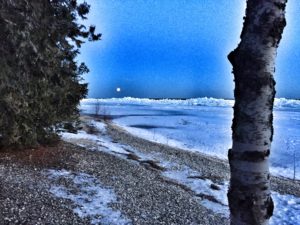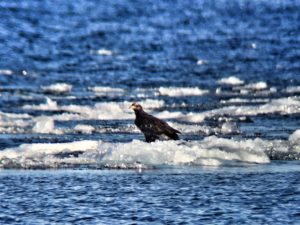
Weather –
It was a beautiful and still this morning with the moon setting to the west when I arrived. Temperatures hovered around 27 degrees F and the barometer was steady throughout the day. That quickly changed when the winds kicked up to nearly 30 kph by 10:30AM. This caused the rafts of ice that were parked out to the NW of the straits to slowly drift over to the south shore that I count from. This additional ice grinding against McGulpin point caused the blue ice wall to the NW of the count site to grow again in elevation maybe maxing out at 12 ft. The temperatures barely climbed to above freezing by the end of the count at 3:30PM. A nice bank of cumulus clouds formed over the northern shore of the straits. Other than the low clouds sifting through the straits it was mostly sunny today.
Waterbird Notes –
The Red-breasted Merganser were the most numerous waterbirds detected as has been the case so far this season. White- winged Scoter, Long- tailed Duck and a few Common Goldeneye rounded out the waterbirds for the morning. By 11:30 AM things dropped off drastically and I called the count 30 minutes early when I realized there hadn’t been any waterbird detections other than merganser since just before noon. It was impressive to watch the merganser handle the rough waters today that few other waterbirds seemed to fare well in. It was easy to overlook them in the troughs of some of the 2 ft chop, however that also acts as camouflage to predators since they are near invisible at times even with a spotting scope.
Non- waterbird Notes –
Another exciting day was recorded in detail for the non- waterbirds. Just before sunrise the resident Adult Bald Eagle that seems to have a territory closest to McGulpin Point flew low from the shipping channel to the north with a full crop on a southerly flight path. It is my opinion that I never did see this bird again today. A couple minutes after this bird left the straits I noticed 2 more Adult Bald Eagles dogfighting on the northern shore of the straits. I don’t always think of eagles as amazing aerialists but the more dominant eagle certainly gained altitude and banked faster than the bird that was trying to leave the area. The dominant eagle repeatedly gained altitude quicker through powerful wingbeats than the interloper who seemed to be on a mostly level flight path to the south. Once the dominant bird reached higher elevation it then closed the distance between the two birds rapidly. The interloper rolled over on its back flashing its talons once, then took 4-5 more of these attacks before the attack ended abruptly. Once the interloper crossed to the far side of some invisible line its pursuer then broke off the chase and returned to hunt in the shipping channel.
Not more than a couple hours after this show a 3rd year Bald Eagle was spotted flying to the east of McGulpin along the shore ice. I then watched the bird repeatedly dive to the surface of the water only to come up with nothing. I thought for sure the bird was fishing, but as it came close to within 100 meters of the gazebo the prey became obvious. The NW winds that kicked up pushed ice into the shore ice in front of me. This slow closing of the channel limited Red-breasted Merganser ( who were fishing near the shore ice) in their options for take off. One hen that had got separated from the other birds dove under the raft of ice off of the shore ice and when she rose on the far side in open water the eagle dove. It came up empty handed, but it was interesting to note that the bird may have been short on breath and as such each subsequent dive by the eagle resulted in the hen rising faster and more frantically. I thought I was about to witness my first kill on the straits, but the merganser succeeded by persistence and not giving up. I once observed an adult male American Kestrel chasing a migrating passerine that had been blown high up off of the Bridger Mountains in Montana. The kestrel took the passerine after 6-7 swipes. I was impressed with the kestrels aerial superiority, but I was impressed by the tenacity of the small passerine in 40-50mph gusts at over 8,000 ft. The eagle then perched in front of me to regroup and float stealthily on the moving raft of ice before setting off to repeat the process. Now I understand a little more of what the resident Bald Eagles are doing when I see them perched on a prominent piece of blue ice on an ice raft drifting in the straits. This spectacle made me reflect on a quote from Charles Darwin that I think about daily:
“When we reflect on this struggle, we may console ourselves with the full belief, that the war of nature is not incessant, that no fear is felt, that death is generally prompt, and that the vigorous, the healthy, and the happy survive and multiply.”

At 10:37 AM I spied through the spotting scope a lone Sandhill Crane flying high at the base of the cumulus clouds at what appeared to be just over the top of the highest supports on the bridge. This lone SACR signaled a solid flight of raptors from my vantage point. Next up was an adult light Red- tailed Hawk which crossed the straits effortlessly, but upon reaching the far shore it quickly dropped into the forest to perch. When Ed visited later in the afternoon he mentioned the flight line that bird was on was the shortest point to point crossing of the straits. Next up was two Golden Eagles winging their way over the bridge at the base of cumulus clouds that I was able to spot them against. These birds appeared to be working pretty hard to get across the straits, but once they approached the far shore they glided a bit on their up swept wings. They where unlike the Bald Eagles that reside in the area, flying higher, point to point and not dropping to the shoreline on the far side. These birds continued on to the east following the north eastern shoreline of the straits out of view.
By now I was cheering the day vocally for the amazing flight I was witnessing. Undoubtedly the cloud cover helped with detections. Now that I have one of the flight lines figured out I will definitely be scanning that area routinely. In that same hour I also saw an Unknown Buteo, but it disappeared in the low clouds before I could sort it out.
Another notable observation today was a Pine Siskin that joined me under the roof of the gazebo. The bird was busy collecting nesting material. I was impressed with the birds ability to strip bark off the logs in the gazebo and literally fly away while tearing the bark free. I told the siskin it was doing excellent work.
Visitors –
Ed Pike brought down a much welcomed snack of fresh grapes and cheese which I promptly wolfed down. This was greatly appreciated, so thanks to Bev Kirby!
A reporter from the St. Ignace News visited with Ed and I on a story he is working on about migration and MSRW. Another reporter from a local paper here in Mackinaw City arrived shortly thereafter. I will keep you posted when these articles run. My chickadees are getting to be pretty famous.
Total observer hours – 8.0
Next days forecast –
Snow, mainly after 8am. The snow could be heavy at times. High near 35. Northeast wind 5 to 10 mph becoming south 10 to 15 mph in the afternoon. Winds could gust as high as 35 mph. Chance of precipitation is 100%. New snow accumulation of around 5 inches.
Canada Goose – 5
White- winged Scoter 4
Long- tailed Duck – 5
Common Goldeneye – 2
Common Merganser – 7
Red-breasted Merganser – 67
duck sp. – 48
Ring- billed Gull – 4
Herring Gull – 3
gull sp. – 70
Golden Eagle – 2 U
Bald Eagle – 5 A 1 S3 1 I
Red- tailed Hawk – 1 AL
Unknown Buteo – 1
Sandhill Crane – 1
Mourning Dove – 1
American Crow – 10
Black-capped Chickadee – 2
Red- breasted Nuthatch – 2
Golden- crowned Kinglet – 1
American Robin – 3
Northern Cardinal – 1
Red- winged Blackbird – 1
Common Redpoll – 30
Pine Siskin – 4 ( carrying nesting material )
